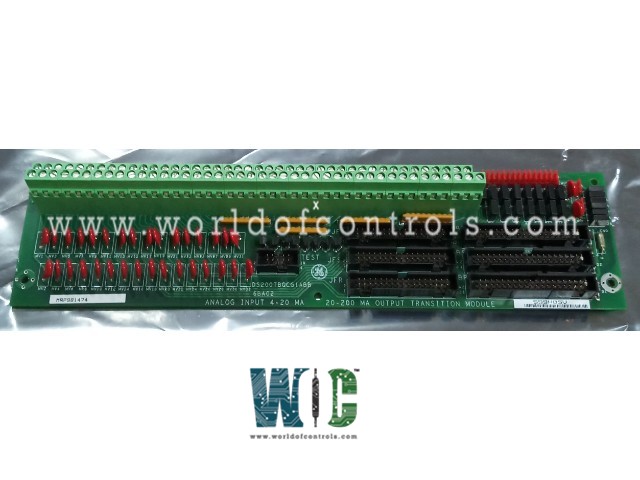SPECIFICATIONS
Part No.: DS200TBQCG1AAA
Manufacturer: General Electric
Country of Manufacture: United States of America (USA)
Product Type: Analog Input Termination Module
Availability: In Stock
Series: Mark V
Functional Description
DS200TBQCG1AAA is an Analog Input Termination Module developed by GE. It is a part of the Mark V control system. The Analog Input Termination Module (TBQC) is strategically located at position nine within the cores identified as R1, R2, and R3. Its primary function is to facilitate the connection and management of analog input signals within each respective core of the system.
Features
- Specifically, it serves as a conduit for transmitting 4-20 mA inputs and LVDT/R position inputs to the TCQA board located within its corresponding core. These inputs are crucial for monitoring and controlling various parameters essential for system operation and performance.
- In addition to managing inputs, also handles outputs ranging from 20 to 200 mA, which are read from the TCQA boards within the respective cores. These outputs can be configured to operate at either a maximum current of 20 mA or 200 mA, depending on the specific requirements of the application. This configuration is achieved through hardware jumpers installed on the terminal board, providing flexibility and adaptability to meet varying operational needs.
- The ability to configure output currents via hardware jumpers ensures accommodates different operational scenarios and optimizes performance based on specific core requirements. This feature enhances the versatility and functionality of the analog input termination module within the R1, R2, and R3 cores, contributing to efficient data processing and control capabilities across the system.
Connections
- JBR: This connection plays a dual role
- It writes 4-20 mA input signals to the TCQA board located in each respective core. These signals are essential for monitoring various parameters and operational conditions.
- It reads mA output signals from the TCQA board, facilitating feedback and control mechanisms based on processed data within the system.
- JFR: Responsible for transmitting LVDT/R position input signals to the TCQA board in each core. These signals are critical for precise position sensing and control applications within the system, ensuring accurate feedback and operational stability.
- JBS/T and JFS/T: These connections are typically unused in standard operational configurations. They may serve as optional or reserve connections depending on specific system requirements or future expansions.
- TEST: Similarly, the TEST connection is typically unused during regular system operations. It may serve diagnostic or testing purposes during initial setup or troubleshooting scenarios but remains inactive under normal operational conditions.
The WOC team is always available to help you with your Mark V requirements. For more information, please contact WOC.
Frequently Asked Questions
What is DS200TBQCG1AAA?
It is an Analog Input Termination Module developed by GE under the Mark V series.
What signals does the JBR connection handle on the board?
JBR writes 4-20 mA input signals and reads mA output signals from the TCQA board in each respective core. This connection supports monitoring and control functions crucial for system operation.
What is the role of the JFR connection on the board?
JFR transmits LVDT/R position input signals to the TCQA board in each core. These signals are essential for precise position sensing and control applications within the system, ensuring accuracy and stability.
